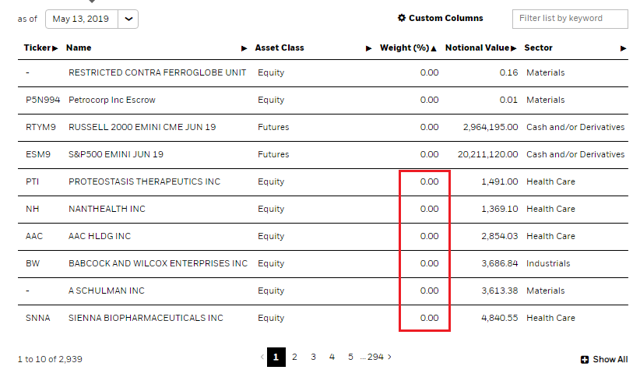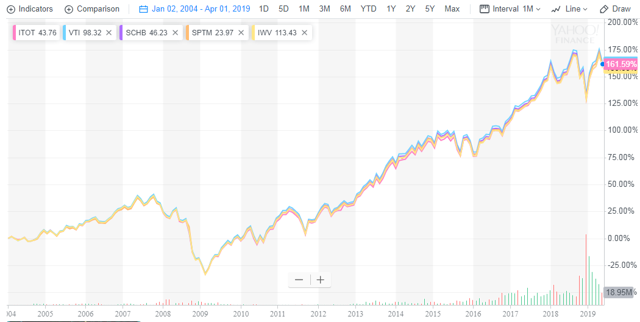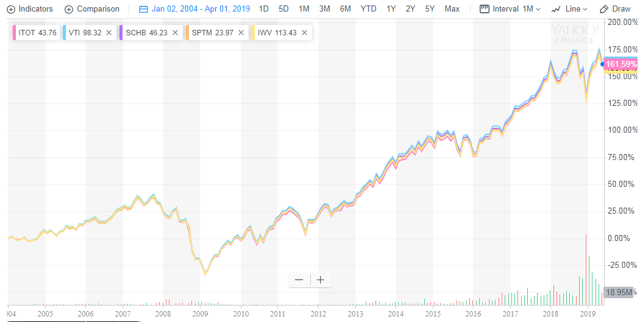[ad_1]
iShares Core S&P Total U.S. Stock Market ETF (ITOT) deserves consideration from investors looking for a total US stock market fund. ITOT has one of the lowest expense ratios and some of the broadest market coverage amongst the competing total stock market funds.
Fund Overview
ITOT tracks the S&P Total Market Index (TMI). This is one of the broadest US stock market indices out there with over 3500 holdings. Here’s how ITOT stacks up versus some other big name competitors.
|
Fund (Ticker) |
Index Tracked |
Expense Ratio |
Holdings |
|
iShares Core S&P Total U.S. Stock Market ETF (ITOT) |
S&P Total Market Index (TMI) |
.03% |
3552 |
|
Vanguard Total Stock Market ETF (VTI) |
CRSP US Total Market Index |
.03% |
3615 |
|
Schwab U.S. Broad Market ETF (SCHB) |
Dow Jones U.S. Broad Stock Market Index |
.03% |
2464 |
|
SPDR® Portfolio Total Stock Market ETF (SPTM) |
SSGA Total Stock Market Index |
.03% |
2632 |
|
iShares Russell 3000 ETF (IWV) |
Russell 3000 Index |
.20% |
2934 |
(Source: Fund websites)
The only other fund with as broad a coverage of the US stock market is the Vanguard Total Stock Market ETF (VTI) with 3615 total holdings. The question is does adding hundreds or thousands of very small stocks add any value?
How Broad Should a Total Market Index Be?
While having a broad market index with some of the greatest depth is nice, we are not so sure it really matters for returns for market cap weighted indices. (It would likely be more of an issue for an equal weighted total market fund).
By the time you get to the smallest S&P 600 stock (which would be roughly stock number 900) you are looking at very small companies. The smallest weighted stock in the Vanguard Small Cap S&P 600 ETF is Maiden Holdings (MHLD) with a market cap of $58M. To give you an idea of just how small that is in the context of the index it would take about 20,000 $50M market cap “Maiden Holdings” to equal one trillion dollar market cap technology giant (given market gyrations it seems each of the Apple, Microsoft, and Amazon trio only last a few months at the top of the list).
Even more amusing is that the weights of the smallest companies end up being rounded down to zero (obviously the actual weight is not zero, it’s just below the hundredths of a percent being displayed) when the indices list their holdings. Below is the iShares fund that tracks the Russell 3000 with “just” 2934 stocks.

(Graphic source: iShares website, red highlights author)
As you would expect, given all of the funds track substantially similar indices, performance has been almost identical going back to the beginning of 2004!

IWV, with the highest expense ratio was the lowest performer even though every fund was still tightly clustered together.
Summary
So long as the total market index has, let’s say at least 1500 or 2000 stocks, it’s going to perform and behave very similar to the indices with more holdings. The indices each fund track are comparable enough that investors looking for a core total US stock market ETF are best just choosing amongst the four with the lowest expenses.
Vanguard and Schwab have been at the forefront of the low fund expense wars. If the fee wars continue, it seems more likely that Schwab and Vanguard will cut expenses to stay the cheapest. Investors with taxable accounts may want to stick with those two companies since they cannot easily change funds as taxable gains build up. Given that Vanguard is investor owned, it may represent the best bet for continuing to have low expenses over the years and decades ahead. For investors with retirement accounts, pick your favorite amongst the four with a .03% expense ratio or just throw a dart! You can easily switch in the future should expense ratios fall drastically.
Disclosure: I am/we are long VTI, SCHB. I wrote this article myself, and it expresses my own opinions. I am not receiving compensation for it (other than from Seeking Alpha). I have no business relationship with any company whose stock is mentioned in this article.
[ad_2]
Source link Google News

